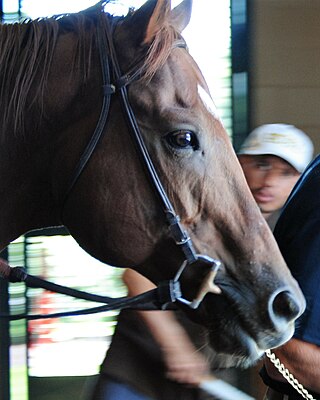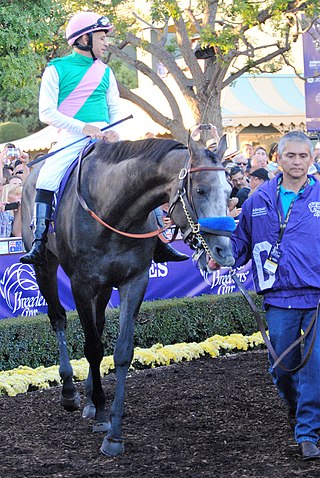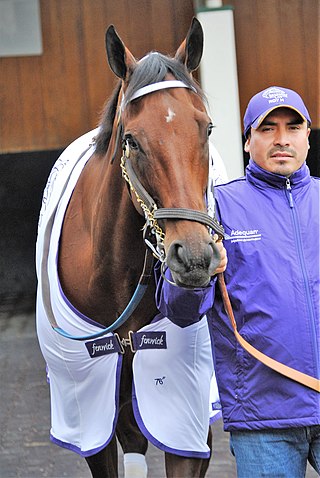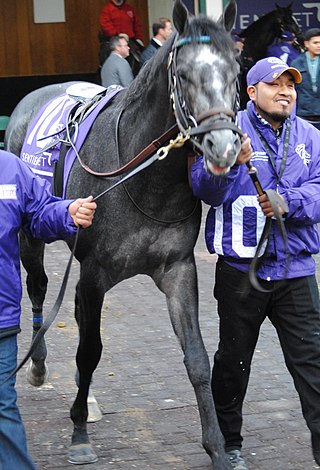
Funny Cide was an American Thoroughbred champion racehorse who won the 2003 Kentucky Derby and Preakness Stakes. He was the first New York-bred horse to win the Kentucky Derby. He was a popular horse and remained a fan favorite in retirement at the Kentucky Horse Park.

Cigar, was an American Thoroughbred racehorse who was the 1995 and 1996 American Horse of the Year. He was the first American racehorse racing against top-class competition to win 16 consecutive races since Triple Crown winner Citation did so between 1948 and 1950. His major wins included the 1995 Breeders' Cup Classic, the NYRA Mile, Jockey Club Gold Cup, Woodward Stakes (twice), Oaklawn Handicap, Hollywood Gold Cup, Donn Handicap (twice) and the first running of the Dubai World Cup. He became the leading money earner in racing history and was later inducted into the National Museum of Racing and Hall of Fame.
Ghostzapper is a Thoroughbred racehorse who won the Breeders' Cup Classic in 2004, outdistancing Roses in May by three lengths in a track record time of 1:59.02. His gate-to-wire Classic victory completed a 4-for-4 season, which earned him the 2004 Eclipse Award for Horse of the Year. He was also ranked "World's Top Ranked Horse" for 2004 as compiled by the World Thoroughbred Racehorse Rankings.

Easy Goer was an American Champion Hall of Fame Thoroughbred racehorse known for earning American Champion Two-Year-Old Colt honors in 1988, and defeating 1989 American Horse of the Year Sunday Silence in the Belmont Stakes by eight lengths. Both horses were later voted into the American Hall of Fame. He is known for his excellence in New York, with running the fastest mile on dirt by any three-year-old in the history in the Gotham Stakes with a time of 1:32+2⁄5, the only horse in racing history to win the Belmont, Whitney, Travers, Woodward and Jockey Club Gold Cup, among others.
The Champagne Stakes is an American Grade I Thoroughbred horse race for two-year-old horses. The race is run at a distance of one mile on the dirt at Belmont Park in October each year. Although the race is open to both colts and fillies, in practice it is New York's premier race for two-year-old colts and fillies enter the Frizette Stakes instead.
The True North Stakes is a Grade II American Thoroughbred horse race for horses aged four years old and older held over a distance of six and half furlongs on dirt scheduled annually in early June at Belmont Park in Elmont, New York. The event currently carries a purse of $350,000.

Lava Man is an American Thoroughbred racehorse who was once claimed for $50,000 but wound up being inducted into the National Museum of Racing and Hall of Fame in 2015. In a forty-seven race career, despite finishing off the board while losing all 5 of his races outside California, he won seventeen times with his major victories including three Hollywood Gold Cups, two Santa Anita Handicaps and the Pacific Classic Stakes.
Holy Bull was a champion Thoroughbred racehorse. Although he finished a disappointing twelfth in the 1994 Kentucky Derby, his major wins that year in the Florida Derby, Blue Grass Stakes, Metropolitan Handicap, Haskell Invitational, Travers Stakes and Woodward Stakes earned him American Horse of the Year honors. He suffered a career-ending injury in the Donn Handicap soon after the beginning of his four-year-old campaign in 1995.

Midnight Lute is an American Thoroughbred racehorse. He was named American Champion Sprint Horse in 2007.
Commentator, is an American Thoroughbred race horse by the stallion Distorted Humor, sire of 2003 Kentucky Derby winner Funny Cide. Like Funny Cide, Commentator is a New York-bred as well as a gelding. Distorted Humor also sired Hystericalady.
Groovy (1983–2006) was an American Thoroughbred Champion sprint racehorse known for his love of jelly donuts. He is the only horse to break the 130 Beyer Speed Figure, accomplishing that milestone in his first two starts of 1987. In the Roseben Handicap at Belmont Racetrack, he earned a 131 rating, which he followed up with a 134 in the True North Handicap.
Formal Gold is a retired Canadian-bred Thoroughbred racehorse who raced in the United States. He is famous for defeating Hall of Fame champion Skip Away in four of their six meetings, with major stakes wins including the Woodward Stakes, Donn Handicap and Philip H. Iselin Handicap. He ran three of the eight fastest Beyer Speed Figures of the 1990s, earning him recognition as one of the best horses who never won a championship.

Speightstown was an American Thoroughbred racehorse who won the 2004 Breeders' Cup Sprint and was named that year's Champion sprinter. He also tied the track record for six furlongs at Saratoga race course. He became one of North America's leading sires.

Arrogate was a Thoroughbred racehorse.

Gun Runner is a US Hall of Fame Thoroughbred racehorse who was the 2017 American Horse of the Year after winning four Grade I races at age four. He retired with earnings of nearly $16 million.

Roy H is a Thoroughbred racehorse who is the two time winner of the Breeders' Cup Sprint. He was named the American Champion Sprint Horse of 2017 and 2018. He did not start racing until age three, when he won only one race, and he was winless at age four. In 2017 at age five however, he developed into the best sprinter in North America by winning the True North Stakes, Santa Anita Sprint Championship and Breeders' Cup Sprint. In 2018, he defended his wins in the Breeders' Cup Sprint and Santa Anita Sprint Championship, plus finished second in the Bing Crosby Stakes and third in the Dubai Golden Shaheen.
Mitole is a retired American Thoroughbred racehorse who was foaled and raised at Hermitage Farm in Oldham County, Kentucky. He was named the American Champion Male Sprint Horse of 2019 after winning six of seven starts that year including the Churchill Downs Stakes, Metropolitan Handicap, Forego Stakes, and Breeders' Cup Sprint.
The Eastern Shore Stakes was an American Thoroughbred horse race run between 1913 and 1949 at Havre de Grace Racetrack, in Havre de Grace, Maryland. A race for two-year-old horses of either sex, it was inaugurated and run for most of its existence as the Eastern Shore Handicap.

Knicks Go is a retired Thoroughbred racehorse who was the 2021 American Horse of the Year after winning five of seven starts, including the Breeders' Cup Classic, Whitney Stakes and Pegasus World Cup. The year before he won the Breeders' Cup Dirt Mile. He is the sixth horse to win two different Breeders' Cup races.
Flightline is an American Thoroughbred racehorse who retired undefeated after six starts, including the 2021 Malibu Stakes and the Metropolitan Handicap, Pacific Classic and Breeders' Cup Classic in 2022. In the January 2023 World's Best Racehorse Rankings, he was given a rating of 140, the highest ever awarded to a runner on the dirt. He was named the 2022 American Horse of the Year and Champion Older Horse.









